Vermont’s Disc Golf Revolution
With big prize money, championship-grade courses and growing local talent, Vermont has become a hotbed for this growing sport.
The situation was laughable: We were at the first tee box of the evening when we realized we hadn’t brought any beer.
I had joined a group of disc golfers for a Wednesday evening game on a 20-hole course Matt Cohen had carved across his 80-acre property in Hinesburg. The evening was a private affair with about 20 people contributing cash to a pot of just over $100 that would go to the winners.
It was late summer and the temperatures were in the 90s with that New England humidity that opens every pore on your body and smothers with a syrupy heaviness. There had been beer and plenty of it; cases of delicious hoppy IPA brewed by Cohen, head brewer at Shelburne’s Fiddlehead and his team. Some of the top brewers in the state, folks from Magic Hat and the Alchemist, were present as well. But due to an oversight, the remaining beer had been left on the front step of Cohen’s house. That was now about a half-mile down the dirt road from where we had paused, and it wasn’t doing anyone any good there.
So there we were, setting out to wander 80 acres of a disc golf course with not even a lukewarm can of Pabst for refreshment. Nobody would stand for it, least of all our host. He took out his phone and made a call.
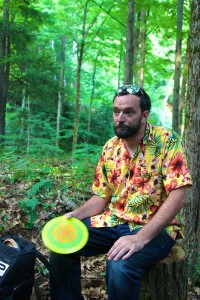
Sporting a brightly colored Hawaiian shirt and a pair of aviator-style sunglasses with reflecting lenses, Cohen—also known as “Matty-O”— looked like a man bound for a tropical vacation. “Could you grab a case when you leave the house?” He asked a group that was just getting started. “Two would be perfect.”
“And three would be better,” someone behind me added.
The crowd split off into a shotgun-style start and I joined Cohen’s foursome with Jeff Spring, director of disc golf at Smugglers’ Notch Resort and board member for the Green Mountain Disc Golf Club; John Moorer, operations manager at Fiddlehead; and Sean Bleything, a transplant who cut his teeth playing on the open grasslands of the Midwest. As Cohen produced a thin disc from a backpack, our group quieted to the respectful whispers you’d find on the back nine at any country club. The disc took flight from his hand.
When basketball star Stephen Curry sinks three-pointer after three-pointer or snowboarder Kelly Clark levitates out of the half-pipe and takes flight, you can’t help but gape. I had a similar reaction as Cohen threaded a nearly 100-yard throw through towering pines. The disc, flying silently as a bird, arced gracefully to the left where it landed on a grassy patch just a few feet from the basket. I was so stunned I dropped my beer.
Watch out, golf.
Imagine a Venn diagram representing craft beer lovers, ultimate Frisbee players, skiers, hikers and golfers and you can pin down the demographic disc golf attracts. While it started there and keeps a core following in that group, the sport has hit the mainstream with more courses opening to the public, new national tournaments and bigger winnings up for the taking.
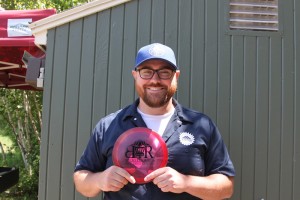
On September 17-18, Smuggler’s Notch hosts the Green Mountain Championship and final stop of the 2016 Disc Golf Pro Tour. The Pro Tour’s championship, high-stakes rounds will draw the country’s top players including three-time World Champion Nate Doss. The live music, party and limited release by Fiddlehead (last year Doss, a beer aficionado, helped create Fiddlehead’s limited release Understable) are sure to attract spectators. But for the more than 280 disc golfers signed up, there are more serious incentives to bring their A-game: a $30,000 cash purse with another $30,000 worth of prizes for the Green Mountain Championship and a $40,000 purse for the Disc Golf Pro Tour.
That’s equal to the projected prize money at the 2016 Vermont Open golf tournament and twice the prize money offered at the 2015 Vermont City Marathon.
Earlier in the week, I’d visited one of the event sites: Smuggler’s Notch’s Brewster Ridge Disc Golf Course, settled in the lush green foothills below Madonna and Spruce peaks and Mount Mansfield’s northern flank.
Jeff Spring met me at a tidy green shed that overflowed with hundreds of brightly colored discs in cardboard boxes and wall-mounted racks. “There’s talk of a larger clubhouse, one with locker rooms, a taproom and a spacious gear shop,” he explained. But in the meantime, my host told me, the cozy shed with its lawn chairs and grill out back (and adjacent porta-john) “was doing just fine.”
As Operations Director for Smuggler’s Notch, Jeff Spring’s summer job involves managing the three disc golf courses around Smugglers’ Notch, as well as the Smuggs’ bike shop up the road. He also serves on the board of the Green Mountain Disc Golf Club (GMDGC) and is the state coordinator for the national Professional Disc Golf Association (PDGA).
The GMDGC manages a list of all the public and private courses around Vermont and helps direct the Green Mountain Point Series, an annual series of 12 games, at courses across the state.
In July, Spring competed in the Stockholm, Sweden on the fourth stop of the European Masters series in the Disc Golf World Tour, placing 131 (Americans made up half of the top 20 spots). To say he’s serious about disc golf is an understatement.
But it wasn’t always that way. After graduating from Northeastern in 2009, Spring played a pared-down version while working as a counselor at a summer camp in Sharon, Vt. and threw for his first baskets at Center Chains, a public 18-hole course in Waterbury with low sugar maples, open fields and tight trees.
Eventually, he was introduced to a course that has existed for 25 years on private property in North Calais, Vt. Hosts Paul Oleander and Dan Desch require players to pay their “dues” by contributing to course maintenance. The regulars also participate in Scotch tastings.
“As soon as you step foot on that course, you know it’s a cathedral for disc golf,” Spring said, describing the densely wooded course with elevation changes and complex layouts that require long and highly accurate throws.
While participation in golf has been on the decline, Spring has watched interest in its quirky cousin—disc golf—rise. According to the National Golf Foundation, participation dropped from a high of 30.6 million golfers in 2003 to 24.7 million in 2014 and continues to stay low. Long-term trends show the number of golfers ages 18 to 34 declining by 30 percent over the last 20 years.
Yet, Spring points out, in five years, membership in the Professional Disc Golf Association has doubled to 80,000 members (with 20,000 people arriving last year) and two new elite-level tours have come online—a world tour and national pro tour.
Spring thinks he understands the reasons behind this growth.
“Unlike the complex mechanics of a golf swing, most people can throw a Frisbee. Equipment costs and greens fees are low and while you need permission to step foot on private courses like that one in North Calais or Matt Cohen’s backyard, there are plenty of clubs that are open for the public to use any time,” he says. Plus, the sport is friendlier to the environment (and cheaper to manage) than courses that are obsessively maintained with gas-powered mowers and wasteful irrigation.
Base Camp Outfitters in Killington, Wrightsville Beach in Middlesex and Center Chains in Waterbury are hailed as “gateway courses” that introduce new players to the sport and until you compete at the highest levels, nobody’s going to give you a hard time for not wearing a polo shirt. At the Trapp Family Lodge, the nine-hole disc golf course appropriately starts and ends at the Alpine Bakery & brewery building. “Greens” fees are often less than $10. A season’s pass at Wrightsville? Just $35.
“It’s a beautiful walk through the woods,” Spring said. “People are calling it golf of a new generation.”
Flow and throw
That night at Matt Cohen’s course, the brewmaster himself handed me a disc and some words of advice with it: “Golf discs don’t behave in the air like a normal disc,” he said. “For a right-handed thrower, they’ll tend to pull down and to the left. Hard.”
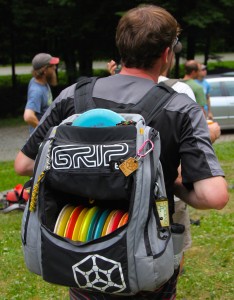 Unlike the hefty 175-gram Frisbees used in ultimate Frisbee, the discs used in disc golf are wafer-thin and weigh between 100 and 180 grams. Like the golf drivers, fairway irons and putters hauled by caddies and carts, disc golfers carry quivers of 20 to 30 discs packed into carriers that resemble combinations of fanny packs, beer coolers and filing cabinets. A peek into a case showed me it could also hold ibuprofen, rosin bags, sunscreen, bug spray and beers—all organized and within easy reach.
Unlike the hefty 175-gram Frisbees used in ultimate Frisbee, the discs used in disc golf are wafer-thin and weigh between 100 and 180 grams. Like the golf drivers, fairway irons and putters hauled by caddies and carts, disc golfers carry quivers of 20 to 30 discs packed into carriers that resemble combinations of fanny packs, beer coolers and filing cabinets. A peek into a case showed me it could also hold ibuprofen, rosin bags, sunscreen, bug spray and beers—all organized and within easy reach.
I nodded, stepped into the box and offered my best throw which, as if attracted by a magnet, flew directly into a pine tree not ten yards away. We all winced.
“Like I said, down and left,” Cohen said.
It takes practice, but Cohen assured me disc golf is easy to pick up.
“The great thing about disc golf is the learning curve is very short,” he said. “If you really dedicate a summer to the sport you will be competitive enough to play with just about anyone.”
Cohen wasn’t introduced to disc golf until he moved from Ithaca, N.Y. and started working at Magic Hat in Burlington. For Cohen, a golfer, the love was immediate. After learning the ropes from a co-worker, he started cutting holes on his property the next day.
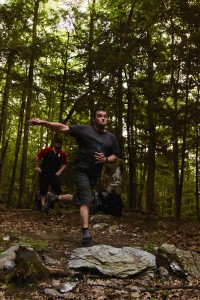 For Cohen, disc golf offers a creativity not found in other sports. “When you can imagine the shot in your mind and make the disc do exactly that, it’s an amazing experience,” he said. “You’ll never be able to do that with a golf ball, unless your goal is to slice.”
For Cohen, disc golf offers a creativity not found in other sports. “When you can imagine the shot in your mind and make the disc do exactly that, it’s an amazing experience,” he said. “You’ll never be able to do that with a golf ball, unless your goal is to slice.”
While my own throw went about as far as a brick, the shots dreamed up by the more experienced players bordered on something artful. John Morer never took a practice throw, but stepped to the edge of the box, squinted briefly down the fairway, and sent the disc flying with a flick of the wrist in low, flat trajectory as if guided by laser. Jeff Spring was the image of composure, tossing a rosin bag between his palms to reduce the moisture that can cause the disc to slip in the hand. He took exactly three steps during his warmups, repeating them until the movement felt natural. He then recreated the same motion before sending the disc zipping through the trees.
As soon as a disc was airborne, a stream of encouragement or profanities ensued from the thrower, depending on the disc’s trajectory.
“Stay right!”
“DROP!”
“You sonuva…”
As a spectator, sometimes it’s best to keep your mouth shut. There is such thing as “nice-ing the disc,” where spectators or fellow players, eager to offer encouragement, will complement the throw as soon as the disc leaves the thrower’s hand. Not everybody takes kindly to it and for some, it jinxes the shot. They may ask you politely and firmly to “get your mouth of my disc.”
Jeff Spring learned the hard way when a disgruntled player hurled his bag after Spring offered comment, scattering discs all over the course. The player received a penalty for unsportsmanlike conduct.
Cohen’s course, along with many of the courses in Vermont, has holes rated at par three or four, but the foliage of the woods always stands to make that a challenge. To even graze a tree can spell disaster and the disc will go bouncing off at a right angle. It’s called getting “tree-nied” and it’s part of what makes the Vermont disc golf environment unique and even difficult.
The fourth member of our group, Sean Bleything from Winooski, started playing in Kansas and has played on flatter and more open courses in Texas, Oklahoma and Iowa. “Out there, the wind is much more of a factor and you have to consider it before every throw,” he said. “When you miss, you can miss by huge margins.”
Here in Vermont, Cohen said the sport requires a different approach.
“It’s more of a finesse game,” he said. “Think of it like tree skiing in the east versus the west.”
And like tree skiing, practice makes perfect.
A sport with a future
Later that night on the back porch of Cohen’s house the grill masters provided a steady stream of burgers, sausages and hotdogs while the players plowed through another case of Mastermind imperial IPA. Scores were tallied and the winnings divvied up.
While disc golf is a sport that values its laid-back roots, the rest of the sporting world is starting to pay attention. The number of people that can pay their bills by sinking discs in the baskets is still small—according to Spring, around 50—but that number has increased as prize purses have grown and pros land sponsorships with disc manufacturers.
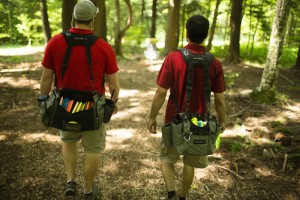 Disc golf’s current top player, Paul McBeth from Huntington Beach, Calif., has won the past four world championships and taken home $268,470 in his career so far, including $72,044 in prize earnings last year—a new record for the sport. Disc golf is also gaining some national visibility and players’ championship performances have been featured in “top 10” recaps on ESPN.
Disc golf’s current top player, Paul McBeth from Huntington Beach, Calif., has won the past four world championships and taken home $268,470 in his career so far, including $72,044 in prize earnings last year—a new record for the sport. Disc golf is also gaining some national visibility and players’ championship performances have been featured in “top 10” recaps on ESPN.
“There are a lot of claims that’s it’s the fastest growing sport in the world or in the country. I’m not sure if that’s true but the bottom line is that it’s growing quickly,” Spring said.
While the growth of the sport means more courses and more opportunities for competitive play, the basics of discs, baskets and friends seemed to be the most important part of its growth.
Waterbury brewer Jim Conroy put it best: “I don’t have a competitive bone in my body,” he said. “But it’s the ultimate competitive, non-competitive sport. I mean look at it: you’re doing your best against yourself (or not) while other people are doing the same thing. What’s not to love?”

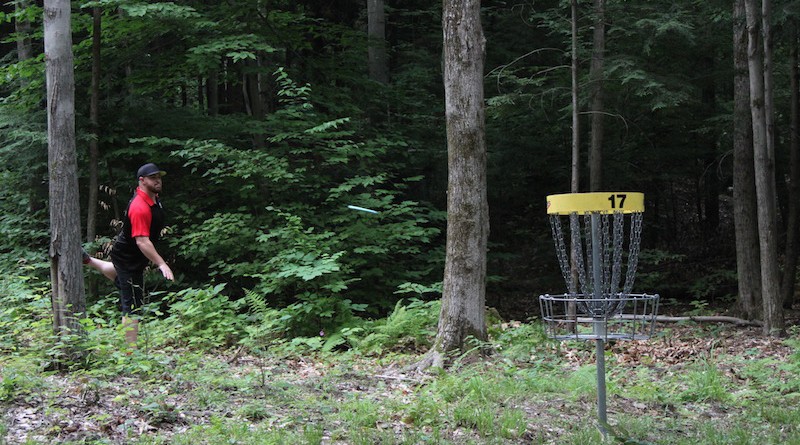
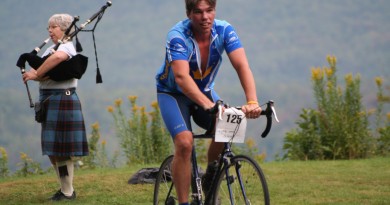
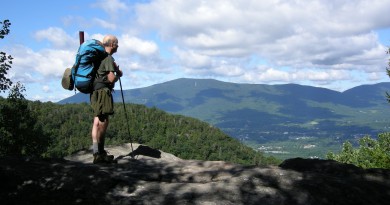
Pingback: Bring On the Pros: Disc Golf Worlds Come to Vermont - Vermont Sports Magazine